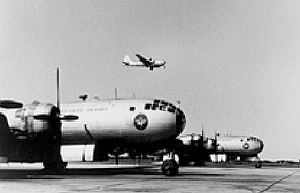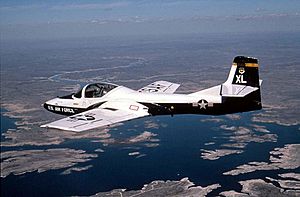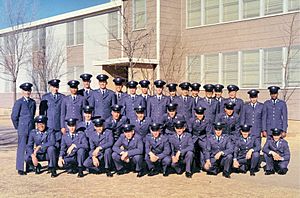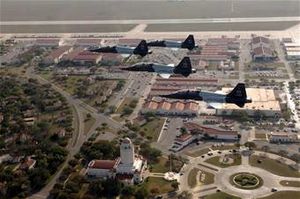Air Training Command facts for kids
Quick facts for kids Air Training Command |
|
|---|---|
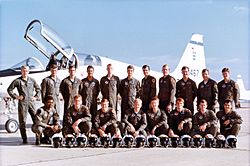 Undergraduate Pilot Training Class photo, Class 81-05, Reese AFB, Texas, c. 1981 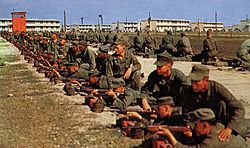 Vietnam War Basic Training on the M-1 carbine Dry Fire range, Lackland AFB, Texas, 1960s 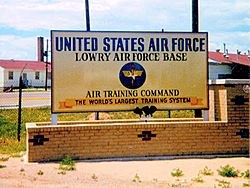 Entrance sign to Lowry AFB Technical Training Center, Colorado, about 1957 |
|
| Active | 1946–1993 |
| Country | |
| Branch | |
| Type | Major Command |
| Role | Air Force Basic, Flight and Technical training |
| Garrison/HQ | Randolph Air Force Base, Texas |
| Nickname(s) | ATC |
| Motto(s) | Prepare the Man |
| Decorations | Air Force Organizational Excellence Award (9x) |
| Insignia | |
| Emblem of Air Training Command | 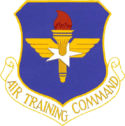 |
The Air Training Command (ATC) was a major part of the United States Air Force (USAF) for almost 50 years. It was in charge of training new Air Force members. This included pilots, aircrews, and people learning special technical skills. It also handled basic training for all new recruits.
ATC was created on July 1, 1946. It took over from the Army Air Forces Training Command after World War II. Its main office was at Randolph Air Force Base in Texas. In 1993, the ATC joined with Air University to form a new command called Air Education and Training Command (AETC). The AETC still does the important job of training today.
Contents
History
Postwar era
Formation
After World War II ended in 1945, the U.S. military started to send many soldiers home. This process was called demobilization. Because of this, the Army Air Forces Training Command became much smaller. Many training bases closed down.
On July 1, 1946, the command was renamed Air Training Command (ATC). Its goal was to become the main training group for the postwar U.S. Army Air Forces. When the United States Air Force became its own military branch in September 1947, ATC became one of its most important commands.
Organization
ATC was set up with three main parts:
- The Flying Training Division, which taught pilots how to fly.
- The Technical Training Division, which taught special skills like fixing aircraft.
- The Indoctrination Division, which handled basic training for all new recruits.
In 1947, the Air Force became a separate service. By the end of that year, ATC had 13 training bases. However, it faced big challenges. There weren't enough people or money to train everyone needed for the new Air Force.
The first training bases for Air Training Command included:
|
|
Training
ATC started training pilots to fly jet planes in 1946. But it was hard because there were no special jet trainer planes with two sets of controls. The pilot training program was also simplified into two main stages: Basic and Advanced.
The Technical Division was responsible for training teams for cold weather survival. They taught Air Force members how to survive and use equipment in very cold places. However, budget cuts meant they had to use military personnel as instructors, even if they didn't have much teaching experience.
The Indoctrination Division brought all basic training to Lackland Air Force Base in 1946. But many experienced instructors left the military after the war. This made it hard to train new recruits.
Berlin Airlift
By 1948, ATC was still struggling with a shortage of instructors. Then, the Berlin Blockade happened. This meant the Air Force needed to send many people to support the Berlin Airlift. ATC had to give up some of its experienced staff, which made training even harder. They even had to consider closing some new training bases.
Consolidation of Divisions
When the Berlin Blockade ended in 1949, the Air Force faced more budget cuts. This led to changes and less training. To save money, ATC combined its separate training divisions into one main command structure.
Korean War
When the Korean War started in June 1950, ATC's training needs grew very quickly. The Air Force told ATC to speed up training to get more pilots, navigators, and aircrew ready for combat. ATC also started a new mission: training combat crews.
To meet the demand, ATC opened new schools, including one at Nellis Air Force Base. The number of pilots needed each year jumped from 3,000 to 7,200. ATC also worked with civilian schools to help with the training.
Some of the contract primary pilot training bases during the Korean War were:
|
The Korean War also caused Lackland Air Force Base to become very crowded. In early 1951, the number of people at Lackland jumped from 36,513 to over 70,000. New recruits often had to sleep on canvas cots without mattresses because there weren't enough supplies.
To handle the large number of new recruits, ATC opened two more basic military training bases: Sampson Air Force Base in New York and Parks AFB in California. These bases helped train thousands of new Airmen.
All technical training programs started running six days a week to speed things up. This meant students were trained faster and could join the field sooner. However, the quality of training sometimes suffered because there wasn't enough time to prepare. ATC also faced shortages of equipment like spare parts for aircraft.
As a result of the war, ATC brought back its training divisions. These included the Flying Training Air Force (FTAF) and the Technical Training Air Force (TTAF). A third group, the Crew Training Air Force, was also created to train combat crews.
Cold War
Even during the Korean War, the Air Force continued to grow to face the threat of the Cold War with the Soviet Union. ATC kept expanding, opening five more flying training bases.
By 1952, ATC had 176,446 personnel. The training program changed to a four-phase pilot training system. This included preflight, primary, basic flight, and crew training.
After the Korean War ended in 1953, military budgets were cut. ATC closed its basic training schools at Sampson and Parks AFB in 1956.
In 1960, ATC started a new idea called consolidated pilot training (CPT). This combined the first three phases of pilot training. ATC also decided to replace all civilian flying instructors with military officers and close all contract primary schools by 1961.
Many of ATC's facilities were given to other commands in the 1950s. Over ten years, ATC reduced its bases from 43 to 16. In 1954, ATC also took over the job of recruiting new Air Force members. In 1957, ATC's main office moved to Randolph AFB, Texas, to save money.
In 1959, ATC started using the Cessna T-37 Tweet jet trainer for primary pilot training, replacing older propeller planes.
Vietnam War era
In the early 1960s, ATC changed its pilot training to be more general. This meant all pilots received the same training, no matter what type of aircraft they would fly later. The T-38 Talon jet became the main advanced trainer aircraft.
When the Vietnam War increased in 1965, Air Force training also increased. However, ATC didn't need to open many new bases or hire many more people. This was because they used a "split-phase" basic military training program and focused on general technical training.
Pilot training slowly increased during the war. But many of ATC's best instructors were sent to combat units, which made training harder. In 1969, ATC also helped train and equip the Republic of Vietnam Air Force, which greatly increased technical training.
In 1966, Amarillo Air Force Base became a basic training center to help with the increased number of recruits. However, Amarillo AFB closed in 1968.
Post-Vietnam era
As the Vietnam War ended, ATC's training needs decreased. In 1973, President Richard Nixon ended the military draft, making the military an all-volunteer force.
ATC changed its approach to technical training. Instead of teaching everything, they focused on the skills recruits needed for their first enlistment. This made training shorter and cheaper. The Community College of the Air Force was also created in 1972 as part of ATC to help attract better recruits.
More opportunities opened for women in the Air Force during this time. The first class of 10 women pilots received their wings in 1977.
To save money for new fighter jets like the F-15 and F-16, ATC closed some bases like Craig AFB and Webb AFB. They also used more flight simulators and reduced flying hours in pilot training.
In 1978, ATC took over responsibility for Air University and cryptologic (code-breaking) training. However, Air University became a separate command again in 1983.
In the early 1980s, during the Reagan Administration, ATC was able to improve training. They added more flying hours to pilot training and made the course longer. In 1981, ATC also started training pilots from NATO countries under a special program at Sheppard AFB.
By 1984, increased budgets allowed ATC to train technical personnel more fully again. However, military spending cuts began in the late 1980s. When the Berlin Wall fell and the Soviet Union collapsed, the Cold War ended. This led to even more cuts in military spending.
Persian Gulf War and post-Cold War reorganization of the 1990s
During the Persian Gulf War in 1990, ATC sent over 3,000 of its staff to help other commands. They also called up Air Force Reservists and retirees to fill positions. Fortunately, the war ended quickly with few American casualties.
ATC continued to combine its training efforts. In 1993 and 1994, several bases like Chanute AFB, Mather AFB, Williams AFB, and Lowry AFB were closed.
Finally, on July 1, 1993, the Air Force merged Air University and ATC. The command was renamed the Air Education and Training Command (AETC). This created one big organization for all Air Force education and training.
Lineage
- Established as Air Corps Flying Training Command on January 23, 1942
- Renamed: Army Air Forces Flying Training Command around March 15, 1942
- Renamed: Army Air Forces Training Command on July 31, 1943
- Renamed: Air Training Command on July 1, 1946
- Renamed: Air Education and Training Command on July 1, 1993
Assignments
- Headquarters, United States Army Air Forces, July 1, 1946
- Headquarters United States Air Force, September 17, 1947 – July 1, 1993
Headquarters
- Barksdale Field (later, AFB), Louisiana, July 1, 1946
- Scott Air Force Base, Illinois, October 17, 1949
- Randolph AFB, Texas, September 15, 1957 – July 1, 1993
Major Training Units and Bases
ATC had many different units and bases for training. These included:
- Divisions: Like the Technical Division at Scott Air Force Base, the Indoctrination Division at Lackland AFB, and the Flying Division at Randolph AFB.
- Air Forces: Such as the Crew Training Air Force, Flying Training Air Force, and Technical Training Air Force, located at bases like Randolph AFB, James Connally AFB, and Gulfport AFB.
- Centers: Including the Goodfellow Training Center at Goodfellow AFB and the USAF Aerospace Medical Center at Brooks AFB.
- Service: The USAF Recruiting Center in San Antonio, Texas.
- Corps: The Air Force Reserve Officers Training Corps at Maxwell AFB, Alabama.
- Wings: Many different wings for combat crew training, flying/pilot/navigator training, medical training, military training, and technical training. Some examples include the 12th Flying Training Wing at Randolph AFB, the 14th Flying Training Wing at Columbus AFB, and the 3380th Technical Training Wing at Keesler AFB.
- College: The Community College of the Air Force at Maxwell AFB, Alabama.
- Schools: Like the USAF Medical Service School at Brooks AFB and the USAF Officer Training School at Lackland AFB.
See Also
- Air Education and Training Command
- Air University (United States Air Force)
- List of Major Commands of the United States Air Force
Images for kids




